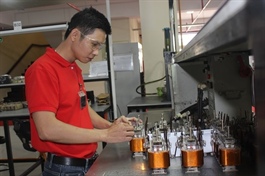EVFTA – for a mutual future beyond tariff elimination
EVFTA – for a mutual future beyond tariff elimination
In the context of still depressed global trade, the long-awaited EU-Vietnam Free Trade Agreement (EVFTA) has come into force in August 2020. A bit of light in these dark times, this FTA offers significant benefits to Vietnam in the years to come.

By Julien Brun -Managing partner, CEL Consulting
|
The EVFTA is the most comprehensive and ambitious trade and investment agreement that the European Union has ever concluded with a developing country in Asia. Vietnam will have access to a potential market of approximately 446 million people and a total GDP of $14 trillion.
Meanwhile, exporters and investors from the EU will have more opportunities to access one of the largest and fastest-growing countries in Southeast Asia.
This is an unprecedented tariff elimination for a country like Vietnam, proving its aspiration for deeper integration and trading relations with the EU.
When referring to an FTA, immediate attention is laid on tariff elimination. It is indeed the most practical and obvious outcome of such agreements. The EVFTA is no exception and within seven years from now, nearly all customs duties – over 99 per cent of tariff lines – will have been eliminated.
Vietnam and the EU are considered to be two supporting and complementary markets. In other words, Vietnam exports goods that the EU cannot or does not produce itself, and vice versa.
Complying with frameworks
However, while EU companies will directly benefit from significant tariff eliminations, Vietnamese firms will have to navigate between different preferential tariff frameworks in place for some time. EU tariffs for Vietnamese exports are already under the Generalised Scheme of Preferences (GSP) which offers already partial or full removal of customs duties on two-thirds of tariff lines.
Consequently, the tariff benefits offered by this FTA will have to be reconciled with the GSP ones. Trading companies will have to comply with both frameworks until the generalisation of free trade in 2027.
However, while the idea of zero tariffs is exciting, the transition promises to be cumbersome, particularly for smaller companies. Finding their way to new administrative requirements will be particularly challenging for the firms that are not equipped with legal and tax advisors – not to mention the fact that exporters will also have to comply with different rules and conditions under other important trade agreements Vietnam has committed to.
Thus, the net advantage may not be as great for Vietnamese companies under GSP than it will be for EU companies that were not initially having preferential access to the local market. From the EU standpoint, the FTA is also a way to reduce the massive trade deficit that Vietnam has been enjoying for decades (€23.3 billion – $27.67 billion in 2019). More imports from the EU to Vietnam are clearly expected.
The duties reduction and administrative simplification will attract new EU players into the Vietnamese market, thus offering more choice for its consumers but also driving significant capital investments. This will support local infrastructures and jobs development in sectors where Vietnam still needs to catch up. That is where EU capital can bolster the industrial capabilities of the country.
Mutual benefits are by principle at the core of the deal and we need to expect a significant increase of competition for local firms with solid, mature, and innovative EU players entering the playground.
Local businesses would have two choices: compete or partner. In both cases, the outcomes for the domestic economy will be positive.
Upgrading standards
Of course, the EVFTA will quickly boost Vietnamese exports, but the deal goes far beyond liberalising tariffs: what may benefit Vietnam most on the long run are hidden among the principles and conditions that both parties mutually committed to.
This trade agreement also covers regulatory standards, health and safety rules, investment, banking and finance, intellectual property, labour, the environment, and many other subjects. Its scope is well beyond national borders and seeks deep and sustainable integration among the parties.
Practically, its tough requirements will invite companies to reinvent their supply chains, to upgrade standards, technicity, and transparency. More specialised manufacturing capabilities, more advanced logistics infrastructure, more integrated and faster processes, more sustainable agriculture, better environmental protection – this is what this FTA is also about, and no one would deny the benefits of such progress for Vietnam.
Also, the strong emphasis on the rule of origin, which is one of the core conditions for tariff removal, will have a deep and positive impact on Vietnam’s industrial development. In the manufacturing sector today, the country shines by its ability to assemble products with components that are mostly imported. The rule of origin invites companies to invest into a deeper layer of the supply chain – more locally-made materials and components to feed large-scale assembly plants are expected to be developed, allowing Vietnam to be more autonomous and thus resilient.
As an example, Thailand managed to go beyond pure assembly and successfully developed its local supply base, noticeably in the electronics and automotive sectors.
Furthermore, the agreement puts an unprecedented focus on sustainability. The EU will also encourage Vietnam to innovate or co-innovate to minimise the environmental footprint of both products and their supply chain. The use of plastics should be reduced, plants and fishes should not be pumped full of chemicals, sea freight should be preferred to airfreight, animals should not be treated badly, recycling should be strongly promoted, and water not wasted. That’s also what will boost Vietnam’s transition to a sustainable and circular economy.
The EVFTA offers a wide range of new opportunities for companies in Vietnam to supply goods and services to the EU. Given the importance of the EU market to Vietnam’s export profile, the new benefits offered by this agreement will definitely increase the competitiveness of Vietnamese firms in Europe. Beyond competitiveness, Vietnam should see this as an opportunity to upgrade its industrial capabilities, towards more effective, more integrated, and more sustainable supply chains.






















